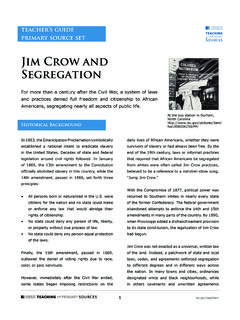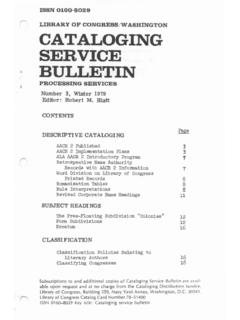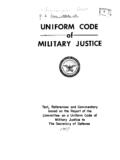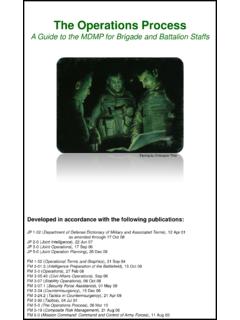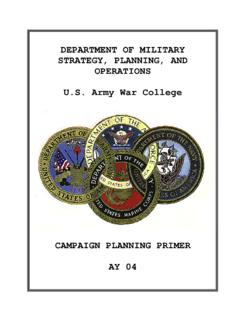Transcription of Operational Law Handbook, 2015 - Library of …
1 CHAPTER 24 THE MILITARY DECISIONMAKING PROCESS AND OPERATIONS PLANS REFERENCES 1. JOINT CHIEFS OF STAFF, JOINT PUB. 1-04, LEGAL SUPPORT TO MILITARY OPERATIONS (17 Aug. 2011). 2. JOINT CHIEFS OF STAFF, JOINT PUB. 3-0, OPERATIONS (11 Aug. 2011). 3. JOINT CHIEFS OF STAFF, JOINT PUB. 3-33, JOINT TASK FORCE HEADQUARTERS (30 July 2012). 4. ARMY DOCTRINE REFERENCE PUBLICATION 3-0, (22 May 2012). 5. ARMY DOCTRINE REFERENCE PUBLICATION 5-0, THE OPERATIONS PROCESS (17 May 2012). 6. JOINT CHIEFS OF STAFF, MANUAL , JOPES Vol. I ( planning Policies and Procedures) (29 Sept. 2006) (current as of 2 July 2010). 7. JOINT CHIEFS OF STAFF, MANUAL , Adaptive planning and Execution (APEX) planning Formats and guidance (31 Aug. 2012). I.
2 OPERATIONS PLANS AND ORDERS IN THE ARMY ARENA A. The military decisionmaking process (MDMP) is an established and proven analytical process (Figure 1). It is an established planning methodology that integrates the activities of the commander, staff, subordinate headquarters, and other partners to understand the situation and mission; develop and compare courses of action (COAs); decide on a COA that best accomplishes the mission; and produce an operations plan (OPLAN) or operation order (OPORD). The difference between an OPLAN and OPORD is that an OPLAN becomes an OPORD when the commander sets an execution time. The Judge Advocate (JA) must be involved in every aspect of the MDMP, beginning with the Plan Development process, not merely the Plan Review stage. Participation in the Plan Development process enables JAs to assist in the development of a plan that is suitable, feasible, and legal.
3 Judge Advocates can accomplish this by fully integrating themselves into the planning staff and providing direct input into the decision-making process. B. The planning staff will vary in size and composition depending on the complexity of the operation and the size of the unit. The key players in the Brigade Combat Team (BCT) will be the brigade S-3 (operations officer), S-2 (intelligence), S-4 (logistics officer), and the brigade fire support coordinator (FSCOORD). These officers are primarily responsible for taking the brigade commander s intent and producing a workable, thorough OPORD. There are other important members of the planning staff, usually a representative from each of the warfighting functions (WFF; doctrinal replacement for the battlefield operating systems) and perhaps Air Force, Air & Naval Gunfire Liaison Company (ANGLICO), allied and special operations forces (SOF) liaisons, and of course the BJA.
4 These supporting members of the planning staff all take an active part in the planning process and have the responsibility of assisting the key players in fulfilling the commander s intent. Significantly, all these officers have other crucial duties in the BCT. The planning staff comes together upon the receipt of a warning order (WARNO) from higher headquarters, then plans, produces an order, and moves into the execution phase. C. The planning staff at the Division level or higher will usually consist of officers and non-commissioned officers (NCOs) who serve on that staff as their primary duty. The planning staff may be called the Battle Management Cell (BMC) or the Future Plans Group (FPG). The Operational law (OPLAW) attorneys at the Division level will work on a daily basis with the BMC. The relationship between those JAs and the officers who make up this planning cell is as crucial as the JA s knowledge of relevant legal issues.
5 D. OPLAW Concerns in Plans and Orders. By fully participating in the MDMP, JAs can engage the staff on legal issues during the planning process as well as review the plans and mission orders for all legal issues. Legal issues may be found throughout the plan; therefore, the JA should read the entire plan. The JA must know the law and be able to identify Operational issues that raise potential legal issues. Every plan will address many OPLAW issues including, but not limited to, rules of engagement; criminal jurisdiction; claims; displaced persons; riot control agents; command and control; and fiscal law. The Legal Annex provides the JA a place to capture guidance on policy matters contained in other annexes throughout the plan. 463 Chapter 24 MDMP and OPLANS Key Inputs Higher headquarters plan or order or a new mission anticipated by the commander Higher headquarters plan or order Higher headquarters knowledge and intelligence products Knowledge products from other organizations Design concept (if developed)
6 Mission statement Initial commander s intent, planning guidance , CCIRs, and EEFIs Updated IPB and running estimates Updated assumptions Updated running estimates Revised planning guidance COA statements and sketches Updated assumptions Updated running estimates Refined COA Evaluation criteria War-game results Updated assumptions Updated running estimates Evaluated COAs Recommended COA Updated assumptions Commander-selected COA and any modifications Refined commander s intent, CCIRs, and EEFIs Updated assumptions Step Step 1: Receipt of Mission Warning Order Key Outputs Commander s initial guidance Initial allocation of time Step 2: Mission Analysis Warning Order Mission statement Initial commander s intent Initial planning guidance Initial CCIRs and EEFIs Updated IPB and ruining estimates Assumptions Step 3: Course of Action (COA) Development Step 4: COA Analysis (War Game) Step 5: COA Comparison Step 6: COA Approval COA statements and sketches Tentative task organization Broad concept of operations Revised planning guidance Updated assumptions Refined COAs Potential decision points War-game results Initial assessment measures Updated assumptions Evaluated COAs Recommended COAs Updated running estimates Updated assumptions Commander-selected COA and any modifications Refined commander s intent, CCIRs, and EEFIs Updated assumptions Warning Order Step 7.
7 Orders Production Approved operation plan or order CCIR commander s critical information requirement EEFI essential element of friendly information COA course of action IPB intelligence preparation of the battlefield Figure 1: The Military Decision Making Process (MDMP). Chapter 24 464 MDMP and OPLANS E. For a detailed description of the MDMP, see Chapter 2 of ADRP 5-0, The Operations Process (17 May 2012). A brief synopsis of the 7-step MDMP is provided below. F. MDMP Step 1: Receipt of Mission. 1. The MDMP begins with the receipt or anticipation of a new mission. The general actions within the receipt of mission step are: alert the staff; gather the tools; update running estimates; conduct initial assessment; issue the commander s initial guidance ; and issue the initial WARNO.
8 Upon receipt of a new mission, the unit s operations section alerts the staff of the pending planning requirement. The unit s standing operating procedure (SOP) will identify who is to participate and where they should assemble. The staff (including the JA) prepares for the mission by gathering the tools needed to conduct mission analysis. These include: a. Higher headquarters order or plan. b. Map of the area of operations (AO). c. Appropriate field manuals. d. Any existing staff estimates. e. SOP for both your own and higher headquarters. 2. The JA must also prepare for the upcoming mission analysis by having the proper resources to include: a. Current ROE with any changes and any requests for changes. b. Relevant status of forces agreement (SOFA) or relevant local law in the anticipated AO. c.
9 Higher headquarters Legal Appendix. d. International and Operational Law Department s Law of Armed Conflict Documentary Supplement. e. International and Operational Law Department s OPLAW Handbook. 3. A critical decision made during the receipt of mission step is the allocation of available time. The commander must provide guidance to subordinate units as early as possible to allow them the maximum time for their own planning and preparation for operations. As a general rule, the commander allocates a minimum of two-thirds of available time for subordinate units to conduct their planning and preparation. This leaves one-third of the time for the commander and his staff to do their planning . The commander will then issue initial planning guidance to the staff. In a time-constrained environment, the commander may decide to abbreviate the MDMP.
10 4. The final task during this step is to issue a WARNO to subordinate and supporting units. G. MDMP Step 2: Mission Analysis. 1. Mission analysis is crucial to the MDMP. It allows the commander to begin battlefield visualization, a combination of situational awareness (achieving a clear understanding of the current state of friendly forces in relation to the enemy and environment) and commander s intent (the desired end state that represents mission accomplishment and the key tasks that will get the force from the current state to the end state). The result of mission analysis is defining the tactical problem and beginning the process of determining feasible solutions. It consists of 17 steps (see Figure 2), not necessarily sequential, and results in the staff formally briefing the commander. The JA has an important role in each step.

